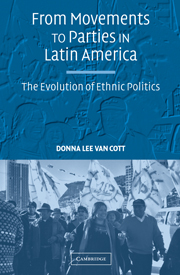Book contents
- Frontmatter
- Contents
- Preface and Acknowledgments
- Abbreviations and Acronyms
- From Movements to Parties in Latin America
- 1 Introduction: Toward a Comprehensive Theory of Ethnic Party Formation and Performance
- 2 Institutions, Party Systems, and Social Movements
- 3 “A Reflection of Our Motley Reality”: Bolivian Indians' Slow Path to Political Representation
- 4 “We Are the Government”: Pachakutik's Rapid Ascent to National Power
- 5 “It Is Not a Priority”: The Failure to Form Viable Ethnic Parties in Peru
- 6 Argentina, Colombia, and Venezuela: Unlikely Cases of Ethnic Party Formation and Success
- 7 Conclusions and Implications
- References
- Index
5 - “It Is Not a Priority”: The Failure to Form Viable Ethnic Parties in Peru
Published online by Cambridge University Press: 04 June 2010
- Frontmatter
- Contents
- Preface and Acknowledgments
- Abbreviations and Acronyms
- From Movements to Parties in Latin America
- 1 Introduction: Toward a Comprehensive Theory of Ethnic Party Formation and Performance
- 2 Institutions, Party Systems, and Social Movements
- 3 “A Reflection of Our Motley Reality”: Bolivian Indians' Slow Path to Political Representation
- 4 “We Are the Government”: Pachakutik's Rapid Ascent to National Power
- 5 “It Is Not a Priority”: The Failure to Form Viable Ethnic Parties in Peru
- 6 Argentina, Colombia, and Venezuela: Unlikely Cases of Ethnic Party Formation and Success
- 7 Conclusions and Implications
- References
- Index
Summary
In many ways the Peruvian case resembles that of Ecuador or Bolivia. The three countries share the history and culture of the central Andes, a proportionally large indigenous population, a militant political left that declined in strength in the early 1990s, and a historically fragmented party system. However, no viable ethnic party emerged in Peru to represent the politically excluded indigenous population.
The main reason for this absence is that Peru's indigenous movement lacked the resources to take advantage of a relatively open institutional and political environment. A national organization that could plausibly claim to represent Peru's indigenous population did not form until 1998, and this has yet to consolidate itself as a permanent institution. Prior to that time, Peru's indigenous people were unable to form a single, unified organizational structure to represent its demands before the state. Not only has the movement been severely divided by region, with separate movements emerging in the Amazon and highlands, even within regions rival organizations struggle for dominance.
Although indigenous communities bear some of the responsibility for this failure, we can also blame the undemocratic context of the 1990s, when President Alberto Fujimori severely restricted the sphere of action for all social movements at a time when indigenous mobilizations had far greater political space in Ecuador and Bolivia. He was able to do so primarily because of the threat of terrorism from the Shining Path (Sendero Luminoso) guerrillas, which enabled Fujimori to label all oppositional activity as terrorism.
- Type
- Chapter
- Information
- From Movements to Parties in Latin AmericaThe Evolution of Ethnic Politics, pp. 140 - 176Publisher: Cambridge University PressPrint publication year: 2005



